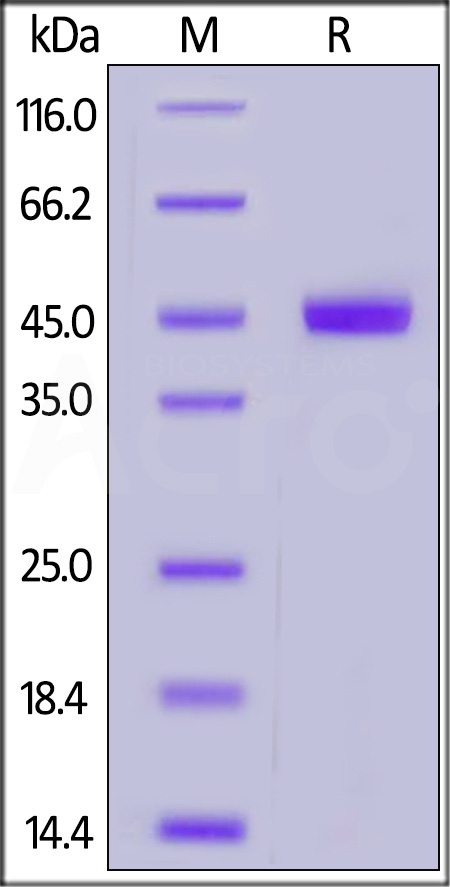分子别名(Synonym)
DC-SIGN,CD209,DC-SIGN1,CLEC4L
表达区间及表达系统(Source)
Human CD209, His Tag (CD9-H5246) is expressed from human 293 cells (HEK293). It contains AA Gln 59 - Ala 404 (Accession # Q9NNX6-1).
Predicted N-terminus: His
Request for sequence
蛋白结构(Molecular Characterization)

This protein carries a polyhistidine tag at the N-terminus
The protein has a calculated MW of 41.3 kDa. The protein migrates as 40-50 kDa under reducing (R) condition (SDS-PAGE) due to glycosylation.
内毒素(Endotoxin)
Less than 1.0 EU per μg by the LAL method.
纯度(Purity)
>90% as determined by SDS-PAGE.
制剂(Formulation)
Lyophilized from 0.22 μm filtered solution in PBS, pH7.4 with trehalose as protectant.
Contact us for customized product form or formulation.
重构方法(Reconstitution)
Please see Certificate of Analysis for specific instructions.
For best performance, we strongly recommend you to follow the reconstitution protocol provided in the CoA.
存储(Storage)
For long term storage, the product should be stored at lyophilized state at -20°C or lower.
Please avoid repeated freeze-thaw cycles.
This product is stable after storage at:
- -20°C to -70°C for 12 months in lyophilized state;
- -70°C for 3 months under sterile conditions after reconstitution.
电泳(SDS-PAGE)

Human CD209, His Tag on SDS-PAGE under reducing (R) condition. The gel was stained with Coomassie Blue. The purity of the protein is greater than 90%.
活性(Bioactivity)-ELISA

Immobilized SARS-CoV-2 S1 protein, Fc Tag (Cat. No. S1N-C5255) at 5 μg/mL (100 μL/well) can bind Human CD209, His Tag (Cat. No. CD9-H5246) with a linear range of 0.039-0.625 μg/mL (QC tested).
Protocol
背景(Background)
CD209 is also known as CLEC4L, DC-SIGN and CD209 antigen. Pathogen-recognition receptor expressed on the surface of immature dendritic cells (DCs) and involved in initiation of primary immune response. On DCs it is a high affinity receptor for ICAM2 and ICAM3 by binding to mannose-like carbohydrates. May act as a DC rolling receptor that mediates transendothelial migration of DC presursors from blood to tissues by binding endothelial ICAM2. Seems to regulate DC-induced T-cell proliferation by binding to ICAM3 on T-cells in the immunological synapse formed between DC and T-cells.























































 膜杰作
膜杰作 Star Staining
Star Staining












